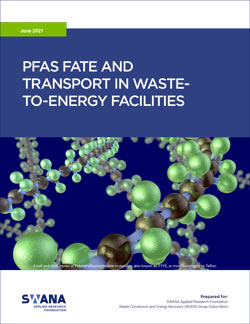Initiatives
PFAS in Waste Conversion & Energy Recovery
Composting
- Much heavier concentrations in food packaging --> 10x (Choi et al., 2019)
- Dominated by shorter-chain
- Not much research in byproducts of composting
- Points of exposure: crops vs. lanscaping
Recycling
- Little research on persistence
- Occupational exposure (dust)
- Secondary processing
Waste-to-Energy (WTE)
Typical time/temperature/turbulence conditions in WTE facilities appear to have the capacity to achieve up to 99% destruction of PFAS. On the other hand, insufficient time/temperature/turbulence may result in products of incomplete combustion (PIC), which may further concentrate PFAS compounds.
- Emissions out of the stack: before/after pollution control
- Ash
Applied Research Answers to Questions about Treating PFAS with WTE Technologies
PFAS Fate and Transport in Waste-to-Energy (WTE) Facilities

The research findings in the report are based on a literature review and an analysis of investigations of PFAS emissions from WTE facilities.
This report is available free to ARF Waste Conversion and Energy Recovery (WCER) Group subscribers. The report will be available for purchase to SWANA members and the general public in June, 2022.
Read the Executive Summary Purchase Report (FREE to Members!)Advertisement
Special Thanks
A special thank you to the Landfill Technical Division Landfill Leachate and Liquids Committee for providing up-to-date scientific and technical data about PFAS in solid waste.
Join Team/Contribute





